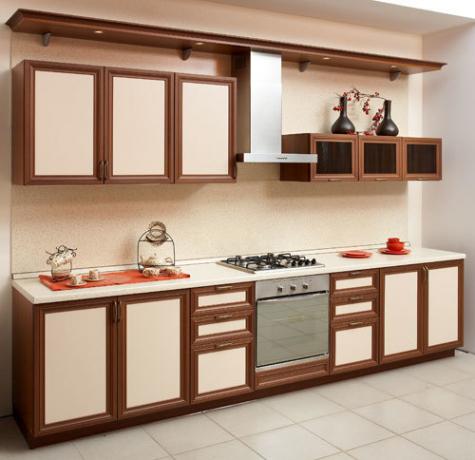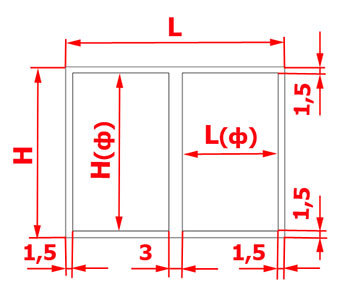Content
-
1 Standardization of sizes of kitchen furniture
- 1.1 General information about dimensional standards
- 1.2 Typical dimensions of kitchen facades
- 1.3 Examples of calculating the dimensions of the kitchen
-
2 Independent calculation of facades
- 2.1 Calculation of gaps for a box with one facade
- 2.2 Calculation of gaps for a box with two facades
In the manufacture of kitchen furniture, manufacturers most often use standard dimensions for kitchen facades. This allows you to optimize the production process so that the machines require a minimum readjustment - but at the same time, such standardization imposes some restrictions on the dimensions of the kitchen furniture.
In our article we will talk about which standards are applied in the production of kitchen facades, as well as how use this information as efficiently as possible in self-design and calculating the dimensions of the kitchen furniture.

Kitchen with standard size fronts
Standardization of sizes of kitchen furniture
General information about dimensional standards
Manufacturers of kitchen fronts (i.e. doors for kitchen units) can produce elements from two categories:
- Standard facades - i.e. facades that are part of the manufacturer's product range and do not require equipment reconfiguration. You can see the kitchen with standard facades in the photo (see. also types of facades for the kitchen).
- Arbitrary (non-standard) facades - facades, the dimensions of which satisfy the maximum and minimum dimensions, but do not fit into the standard dimensional grid in terms of the ratio of height and width (see. which facades for the kitchen are better).

Standard wood fronts
The division of non-standard and non-standard facades is carried out for the reason that the production cost of one square meter of the mentioned facade exceeds the cost of a standard one by about 20%. Consequently, the selling price for the client for such a facade should be higher.
Note!
When buying kitchen furniture with a facade made of expensive materials, the difference in cost can be very unpleasant for the wallet!
It is for this reason that, at a minimum, the standard dimensions of the kitchen facades should be taken into account when designing a set. Of course, in some cases, the dimensions of the kitchen or its configuration categorically do not allow "fit" into standard - but in all other cases, fitting to typical sizes will contribute to a significant savings.

Kitchen layout with standard facades
Typical dimensions of kitchen facades
Each enterprise specializing in the production of kitchen furniture adopts its own standard sizes of kitchen facades.
However, most of these standards are the same for all companies, therefore it is enough to focus on the same data - and with a high probability you can "get" into the dimensional grid of a particular manufacturer.

Facades of standard dimensions
The most common dimensions for kitchen fronts are shown in the table below:
|
Swing facades width x height, mm |
Facades for drawers width x height, mm |
396 x 496 |
140 x 296 |
396 x 596 |
140 x 396 |
570 x 296 |
140 x 446 |
570 x 396 |
140 x 496 |
570 x 446 |
140 x 596 |
570 x 496 |
283 x 296 |
570 x 596 |
283 x 396 |
713 x 296 |
283 x 446 |
713 x 396 |
283 x 496 |
713 x 446 |
283 x 596 |
713 x 496 | |
713 x 596 | |
900 x 296 | |
900 x 396 | |
900 x 446 | |
900 x 496 | |
900 x 596 |
Examples of calculating the dimensions of the kitchen
Using these dimensions, we can independently calculate what size the kitchen modules should have if standard kitchen facades are used.
- For example, the calculation of the height of the lower base will look like this: 713 mm (front height) + 4 mm (gap between the worktop and the upper edge of the facade) + 100 mm (distance between the lower edge of the kitchen unit and the floor) = 817 mm.
- Let's calculate the upper base: 900 mm (facade height) + 2 mm (1 mm gap at the top and bottom of the facade) = 902 mm.
- In the same way, the width of the facades is considered: (446 mm x 2) + 6 mm = 898 mm.
Focusing on the dimensions given in the article and using the schemes for calculating the dimensions, we can do it ourselves calculate our future kitchen in such a way that it fits as much as possible to the standard dimensional grid. Naturally, such a kitchen will cost less!
Independent calculation of facades
Calculation of gaps for a box with one facade
If you are inspired by the video tutorials on this site, you decide to do your own manufacturing of kitchen furniture (in particular, facades), then everyone will definitely need the ability to calculate the size of kitchen facades. Below is an instruction that clearly explains the calculation technology.
The key point in calculating kitchen facades is determining the size of the gaps (indents) of the facade from the edge of the kitchen module. The gaps between the facades not only give them a proper appearance, but also ensure correct operation - just try to open the doors that fit close to each other!

Calculation scheme for the gaps of a single facade
Advice!
Indentation sizes are not normatively regulated, so common sense should be used when choosing the amount of indentation. The optimal gap dimensions are considered to be 1-3 mm.
For example, let's calculate the gaps for the box of the upper kitchen module with height H mm and width L mm:
- Set a gap of 1.5 mm on each side.
- The total clearance in height and width will be 3 mm.
Therefore, the dimensions of our facade will be calculated as follows:
- Front height = H - 3 mm
- Front width = L - 3 mm.
In this case, of course, it is desirable that the dimensions obtained coincide with the standard dimensions given in the table. If there is a difference of 1-2 mm, then you can change the dimensions of the indents, taking them, for example, 2.5 mm on each side.
Calculation of gaps for a box with two facades
With one façade, things are pretty straightforward. But what if there are two facades on the box?

Clearance calculation scheme for a box with two facades
If the facades are the same (and this happens in most cases), then the calculation is carried out according to the same principle:
- Set a gap of 1.5 mm on each side.
- The total height clearance is 3 mm.
- The gap along the width of each facade is 3 mm
Therefore, the dimensions of our facade will be calculated as follows:
- Height of each front = H - 3 mm
- The width of each front = 1 / 2L - 3 mm.
Note!
In this case, there will also be a gap of 3 mm between the facades. If you need to reduce this gap, proportionally increase the size of each facade in width.
These recommendations are only the most general scheme for calculating facades, and it is imperative to make adjustments to them, taking into account the design of specific kitchen models. But the basic principles of determining the dimensions of kitchen facades will undoubtedly be useful to you!
Of course, you shouldn't memorize the standard sizes of kitchen facades given in this article. But to have them at hand and to be guided by them when designing a kitchen is a must!


